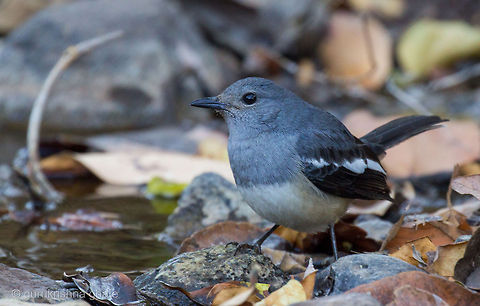
Appearance
This species is 19 centimetres long, including the long tail that is usually held cocked upright. It is similar in shape to the smaller European Robin, but is longer-tailed. The male has black upperparts, head and throat apart from a white shoulder patch. The underparts and the sides of the long tail are white. Females are greyish black above and greyish white. Young birds have scaly brown upperparts and head. It is the national bird of Bangladesh.The nominate race is found on the Indian Subcontinent and the females of this race are the palest. The females of the Andamans race "andamanensis" are darker, heavier-billed and shorter-tailed. The Sri Lankan race "ceylonensis" and southern nominate individuals have the females nearly identical to the males in shade. The eastern populations have more black on the tail and were formerly named "erimelas". The populations in Burma and further south are named as race "musicus". A number of other races have been named across the range including "prosthopellus", "nesiotes", "zacnecus", "nesiarchus", "masculus", "pagiensis", "javensis", "problematicus", "amoenus", "adamsi", "pluto", "deuteronymus" and "mindanensis". However many of these are not well marked and the status of some are disputed. Some like "mindanensis" have been now been recognized usually as full species. There is more geographic variation in the plumage of females than in that of the males.
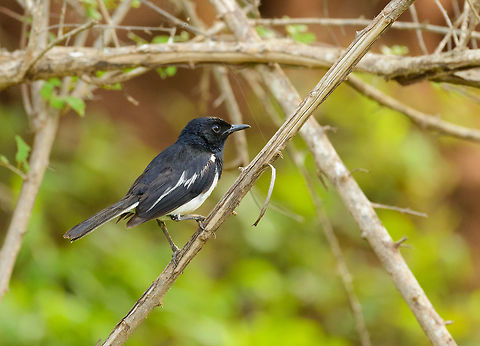
Naming
The Indian name of "dhyal" or "dhayal" has led to many confusions. It was first used by Eleazar Albin in 1737, and Levaillant thought it referred to a sun dial and he called it "Cadran". Thomas C. Jerdon wrote that Linnaeus, thinking it had some connection with a sun-dial, called it "solaris", by "lapsus pennae", "saularis." This was however identified by Edward Blyth as an incorrect interpretation and that it was a Latinization of the Hindi word "saulary". A male bird was sent with this Hindi name from Madras by surgeon Edward Buckley to James Petiver, who first described the species.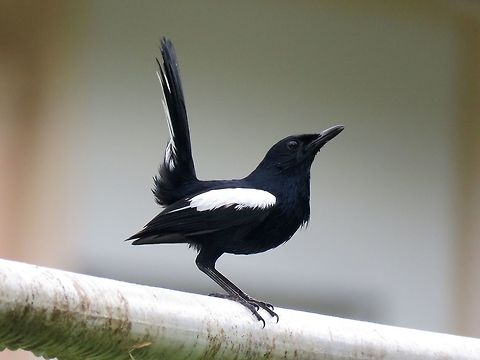
Distribution
This magpie-robin is a resident breeder in tropical southern Asia from Bangladesh, interior India, Sri Lanka and eastern Pakistan east to Indonesia, Thailand, south China, Malaysia, and Singapore. They have been introduced to Australia.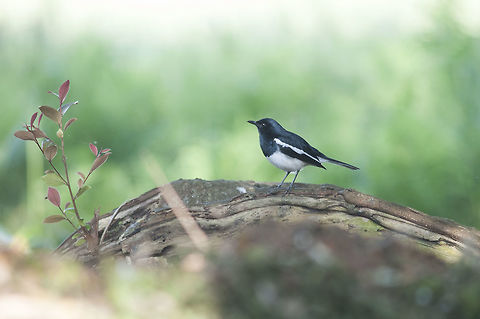
Behavior
It is mostly seen close to the ground, hopping along branches or foraging in leaf-litter on the ground with cocked tail. Males sing loudly from the top of trees or other high perches during the breeding season.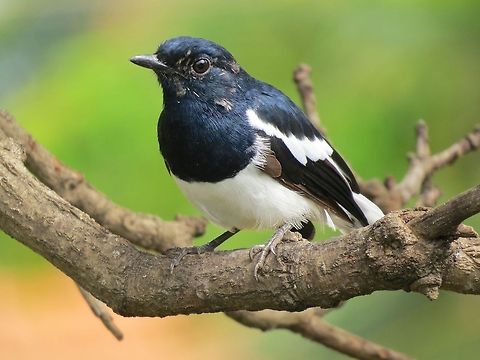
Habitat
The Oriental Magpie-Robin is found in open woodland, cultivated areas often close to human habitations.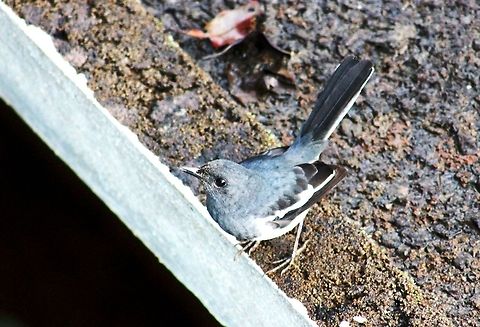
Reproduction
Magpie Robins breed mainly from March to July in India and January to June in south-east Asia. Males sing from high perches during courtship. The display of the male involves puffing up the feathers, raising the bill, fanning the tail and strutting. They nest in tree hollows or niches in walls or building. They are also known to have used artificial nesting areas provided by humans, like Nest boxes. They line the cavity with grass. The female is involved in most of the nest building that happens about a week before the eggs are laid. Four or five eggs are laid in intervals of 24 hours and these are oval and usually pale blue green with brownish speckles which match the color of hay. The eggs are incubated by the female alone for 8 to 14 days. The nests are said to have a characteristic odour.Females spend more effort on feeding the young than males. Males are quite aggressive in the breeding season and will defend their territory. and respond to the singing of intruders and even their reflections. Males spend more time on nest defense. Studies of the bird song show dialects with neighbours varying in their songs. The calls of many other species may be imitated as part of their song. This may indicate that birds disperse and are not philopatric. They appear to use elements of the calls of other birds in their own songs. Females may sing briefly in the presence of male. Apart from their song, they use a range of calls including territorial calls, emergence and roosting calls, threat calls, submissive calls, begging calls and distress calls. The typical mobbing calls is a harsh hissing "krshhh".

Food
The diet of Magpie Robins includes mainly insects and other invertebrates. They usually catch insects in mid-air and take it to a perch to consume it.They often feed in groups of up to 6 members.They also prey on ants by hopping on the ground.These insectivores birds are known to occasionally take geckos, leeches, centipedes and even fish.They are often active late at dusk. They sometimes bathe in rainwater collected on the leaves of a tree.
References:
Some text fragments are auto parsed from Wikipedia.